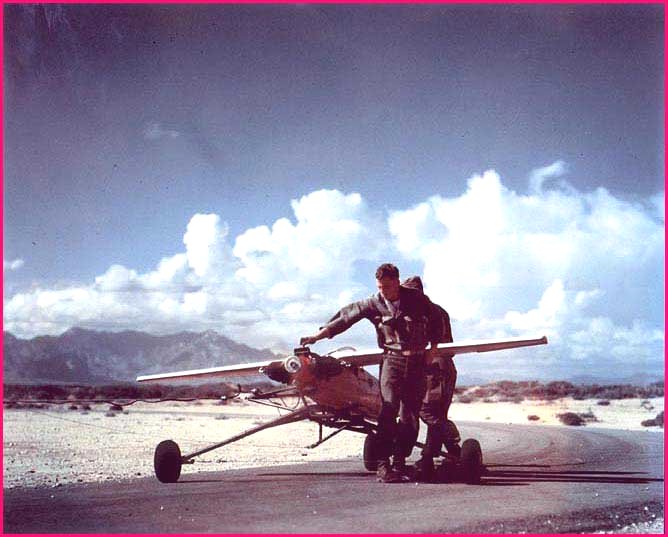
Photo courtesy of the late Lt.Col. John J. McCarthy's family.
OQ-19D RCAT

Photo courtesy of the late Lt.Col. John J. McCarthy's family.
OQ-19D RCAT
Launching RCATS from the Rotary Launcher was very dangerous business, as you can see in this photo. This drone is being prepared for launch, the engine is running full speed, the noise is deafening, and the blast of air from the spinning 44 inch wooden propeller is gale force. The man in front is between the invisible spinning propeller and the wing, adjusting the fuel mixture valve atop the 4-cylinder engine. The man in back is most likely the Radioman. There is a rod driven into the ground on the outside edge of the track. A cable goes from that rod to the trolley to keep it from moving. A lanyard is connected to the trolley end of the cable. When pulled, it releases the trolley.
On the parachute hatch, just aft of the wing, is a pin that holds the hatch closed. That pin is pulled just before the trolley is released. The Radioman will most likely be the one to pull the pin, then pull the lanyard to release the trolley so it can begin to taxi.
When all is ready, both men get out of the way and the drone/trolley begins circling the track, tethered to the center pole.
RCATS have no landing gear, they are mechanically latched atop a trolley with wheels. When the drone is released to race around the circular track and the Launcher Chief is ready to launch, he will remotely unlatch the drone from the trolley and it will become airborne. The trolley stays on the track, ready to load with another drone. This drone has no radar corner reflecting pods attached to the wing tips.
After the drone is airborne, the M-33 radar, located some 1600 yards
from the Rotary, will lock onto it and the Controller will take command
of the flight.
|
|
|
|